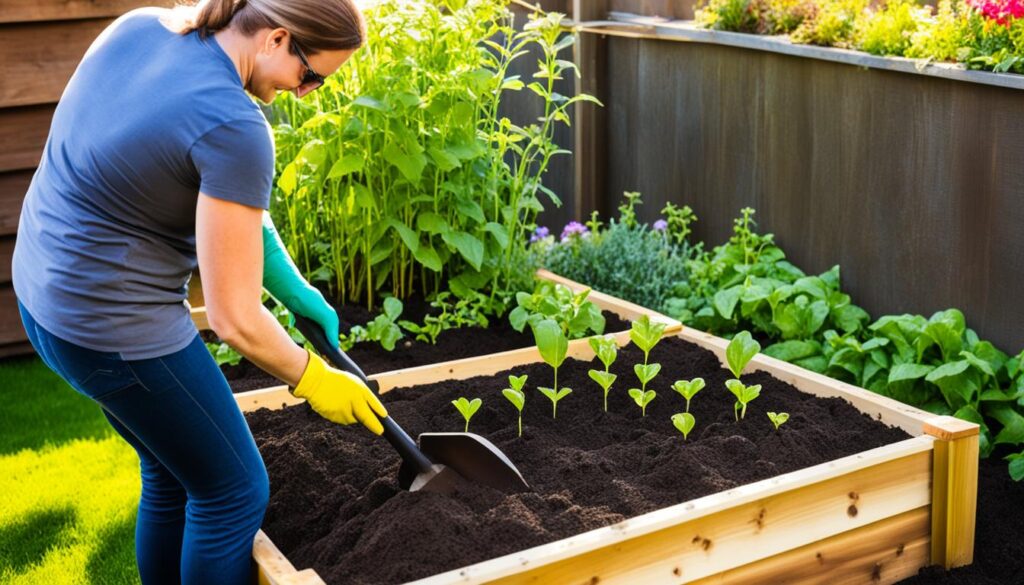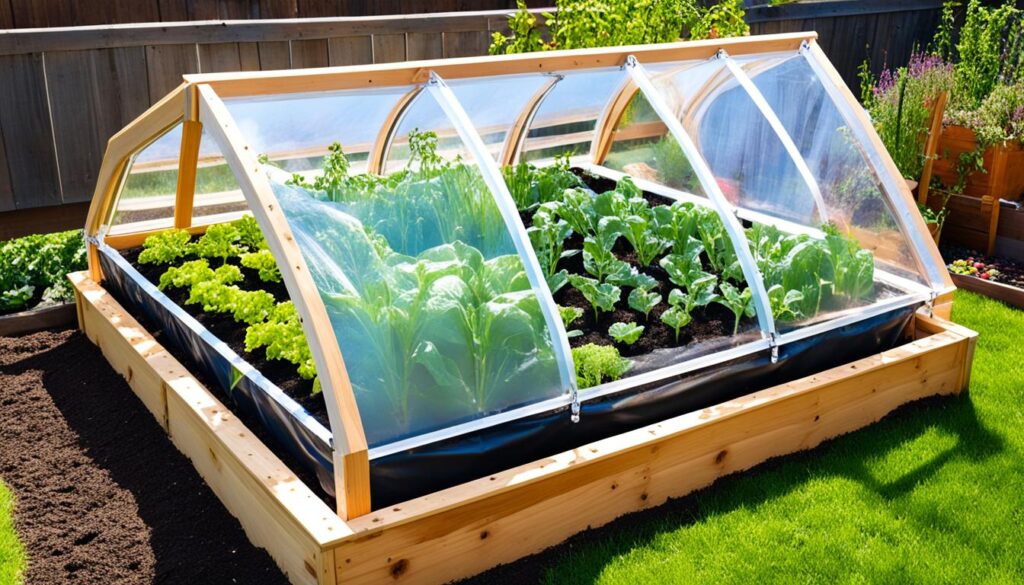Passion flowers are a beautiful addition to any garden, known for their striking blooms and vibrant colors. But can they thrive in shady areas? Let’s explore the shade tolerance of passion flowers and discover which varieties are best suited for growing in shade.
Key Takeaways:
- Passion flowers can tolerate some shade, but they generally prefer full sun to partial shade.
- The common passion flower, Passiflora caerulea, is hardy and can be grown in both full sun and partial shade.
- Some passion flower varieties are more shade-tolerant than others, so it’s important to choose the right variety for your specific growing conditions.
- Passion flowers require at least four to six hours of sunlight a day to thrive.
- They should be planted in well-drained soil and watered regularly.
How to Grow Passion Flowers
Growing passion flowers can be a rewarding experience, but it’s important to provide them with the right conditions to thrive. Here are some tips on how to grow passion flowers successfully:
Choosing the Best Conditions
To ensure optimal growth, passion flowers should be planted in well-drained soil in a warm and sheltered spot. They can tolerate both full sun and partial shade, but they require at least four to six hours of sunlight a day. This ensures that they receive enough energy to produce their beautiful blooms.
Soil and Watering
The soil should be fertile and moist, but not waterlogged. Passion flowers prefer soil that is rich in organic matter and drains well. To enhance drainage, you can add horticultural grit or organic matter such as compost or well-rotted manure to the soil. Watering should be done regularly, allowing the soil to dry slightly between waterings to avoid waterlogging.
Container Gardening
If you have limited space or prefer to grow passion flowers in containers, it is possible to do so. However, it’s important to note that container-grown passion flowers require more frequent feeding and watering compared to those planted in the ground. Choose a large container with good drainage and use a well-draining potting mix specifically designed for container gardening.
The Ideal Support
Passion flowers are climbing plants that require a sturdy support structure to grow and spread. They can be trained to grow up trellises, fences, or pergolas. The plants are self-clinging, so there is no need for tying them in when they mature. Make sure the support is secure and able to withstand the weight of the plant as it grows.
Fertilizing
Passion flowers are heavy feeders and benefit from regular fertilization. Apply a balanced, slow-release fertilizer in spring to promote healthy growth and flowering. Follow the manufacturer’s instructions for the best application rate and frequency.
Pruning
Pruning is essential for maintaining the shape and health of passion flowers. After flowering, remove any dead or damaged stems and trim back excessive growth to keep the plant neat and manageable. Avoid hard pruning, as passion flowers produce flowers on new growth, and cutting back too much may reduce blooming. You can also prune lightly in early spring to retrain overgrown plants.
Common Conditions for Passion Flower Growth
Here is a summary of the best conditions for passion flower growth:
| Condition | Requirement |
|---|---|
| Sunlight | At least 4-6 hours of sun per day |
| Soil | Well-drained, fertile soil |
| Watering | Regular watering, allowing the soil to dry slightly between waterings |
| Support | Sturdy support structure for climbing |
| Fertilizer | Regular feeding with a balanced, slow-release fertilizer |
| Pruning | Remove dead/damaged stems and lightly trim back excessive growth |
By providing the right conditions, passion flowers will reward you with their stunning blooms and unique foliage. Whether you plant them in your garden or in containers, these beautiful climbers are sure to add a touch of exotic beauty to your outdoor space.
Where to Plant Passion Flowers
Passion flowers are versatile plants that can be grown in various locations, but it’s important to choose the best spot to ensure their growth and development. Whether you have a garden or limited space, here are some ideal locations for planting passion flowers:
1. Sunny or Partially Shaded Spots
Passion flowers thrive in areas with ample sunlight. Ideally, they should be planted in a sunny spot that receives at least four to six hours of direct sunlight a day. However, they can also tolerate partial shade, making them suitable for areas that receive a bit less sun. An east-facing location is particularly beneficial as it provides morning sun and protection from intense afternoon heat.
If you have a sheltered, sunny wall or fence, planting passion flowers at the foot of it can create a stunning display of cascading blooms. The wall acts as a natural sun reflector, maximizing the amount of sunlight the plants receive. The flowers will grow up the wall, adding beauty and interest to your outdoor space.
2. Pergolas, Obelisks, and Wire Supports
Passion flowers are vigorous climbers, and they can be trained to grow up various structures such as pergolas, obelisks, or wire supports. These structures provide vertical growing space and support for the vines as they reach for the sun. Not only will this create a visually striking focal point in your garden, but it will also optimize the sunlight exposure for the passion flowers.
“Passion flowers are adaptable and can be grown in containers, but keep in mind that they may not grow as vigorously as those planted in the ground.”
3. Containers
If you have limited space or want to enjoy passion flowers on a patio or balcony, they can also be grown in containers. Choose a large pot that provides enough room for the plants to spread their roots. Use well-draining potting soil and ensure that the containers have drainage holes to prevent waterlogging.
Image:
Comparison of Ideal Planting Locations for Passion Flowers
| Planting Location | Advantages | Disadvantages |
|---|---|---|
| Sunny Spot | Maximizes flower production | May require additional watering in hot climates |
| Partially Shaded Spot | Tolerates less sunlight | Flowers may not be as abundant |
| Foot of a Sunny Wall | Uses vertical space efficiently | May require wall support or training |
| Pergola, Obelisk, or Wire Support | Creates a focal point and vertical interest | Requires additional structures for support |
| Containers | Suitable for small spaces and patios | Plants may not grow as vigorously |
Choose the planting location that best suits your gardening space and needs. Passion flowers are resilient and adaptable, so with the right conditions, they will reward you with their stunning, intricate blooms.
How to Plant Passion Flowers
Planting passion flowers correctly is essential for their overall growth and health. Here are some steps to guide you through the ideal planting and care process:
Choose the right location:
Passion flowers thrive in well-drained soil and prefer a sunny or partially shaded spot. Ensure that the chosen location receives sufficient sunlight, at least four to six hours a day.
Prepare the soil:
Before planting passion flowers, it is important to prepare the soil properly. If you have heavy soils that tend to retain water, improve drainage by incorporating horticultural grit into the soil.
Angle the planting:
When planting passion flowers, consider placing them at a slight angle against the support they will grow on. This will help the plant spread out and establish better.
Water and firm the soil:
After planting, thoroughly water the soil, making sure it is evenly moist. Firm the soil around the base of the plant to provide stability and support.
For those who prefer growing passion flowers in containers, follow these additional steps:
Choose the right container:
Opt for a spacious container with good drainage. Use a gritty, free-draining, and peat-free compost to provide the ideal growing medium.
Planting in containers:
When planting in a container, ensure there is adequate space for the plant’s growth. Place the passion flower in the center of the container and backfill it with the compost mixture. Firm the soil gently around the base of the plant.
By following these planting guidelines, you can ensure your passion flowers get off to a healthy start and thrive in their environment.
How to Care for Passion Flowers
Passion flowers require proper care to ensure their health and vitality. This section will guide you through essential aspects of caring for your passion flowers, including pruning and winter protection.
Pruning Passion Flowers
Pruning is an essential part of caring for passion flowers. After flowering, it’s important to prune the plants to keep them neat and encourage healthy growth.
“Pruning should be done by cutting back to a healthy bud, but there is no need to cut them back hard,” explains horticultural expert Jane Stevens.
If your passion flower plants have become overgrown, you can cut them back in spring for retraining. By pruning properly, you can maintain the desired shape and size of your passion flowers.
Winter Protection for Passion Flowers
Winter protection is crucial for ensuring the survival of passion flowers during cold months.
“Passion flowers grown in containers can be moved to a frost-free place for winter,” recommends Stevens. “Meanwhile, those growing in greenhouses or conservatories should be protected from direct sunlight with shading.”
Damage caused by cold winds should be addressed by cutting back any affected foliage in spring. By providing the necessary winter protection, you can help your passion flowers thrive year after year.
To summarize, caring for passion flowers involves proper pruning techniques and winter protection. Following these guidelines can help you maintain healthy and vibrant passion flower plants in your garden or home.
| Key Care Tips | Benefits |
|---|---|
| Prune passion flowers after flowering to maintain a neat appearance and encourage new growth | 1. Promotes healthy growth 2. Maintains desired shape 3. Encourages more blooms |
| Move container-grown passion flowers to frost-free locations during winter | 1. Protects from freezing temperatures 2. Ensures plant survival 3. Prevents winter damage |
| Provide shading for passion flowers grown in greenhouses or conservatories | 1. Prevents excessive sunlight exposure 2. Protects from sunburn 3. Maintains optimal growing conditions |
| Cut back damaged foliage caused by cold winds in spring | 1. Promotes new growth 2. Enhances overall plant health 3. Restores aesthetic appeal |

How to Propagate Passion Flowers
If you want to propagate passion flowers, you have two main options: cuttings or seed. While growing from seed is possible, it can be a lengthy process with unpredictable results. That’s why propagating from cuttings is generally preferred. Here’s how you can successfully propagate passion flowers using cuttings:
1. Taking Cuttings
Propagation from cuttings is best done in early spring when new growth is just starting to emerge. Follow these steps:
- Select a healthy, vigorous stem from the parent plant.
- Make a clean cut just below a node, using sharp and clean pruning shears.
- Remove any leaves or buds from the lower part of the cutting.
- Fill a pot with cutting compost and create a planting hole in the center.
- Dip the bottom end of the cutting in rooting hormone powder.
- Place the cutting in the planting hole and gently firm the compost around it.
- Water the cutting thoroughly and place the pot in a warm location with bright, indirect light.
- Maintain a consistent bottom heat of around 20°C to encourage root development.
- Keep the compost moist but not waterlogged.
- After a few weeks, check for root development by gently tugging on the cutting. If there is resistance, roots have formed.
- Once the cutting has established roots, you can transplant it into a larger pot or into the garden.
2. Growing from Seed
While propagating passion flowers from seed is possible, it requires patience and can take several months to years before the plant reaches maturity and starts flowering. If you want to give it a try, follow these steps:
- Collect ripe passion flower seeds from a mature fruit.
- Clean the seeds by removing any pulp or residue.
- Soak the seeds in warm water for 24 hours to soften the seed coat.
- Fill seed trays or pots with a well-draining seed-starting mix.
- Sow the seeds on the surface of the soil and lightly cover them with a thin layer of compost.
- Water the soil gently to keep it evenly moist but not waterlogged.
- Place the trays or pots in a warm location with indirect light.
- Maintain a consistent temperature of around 20°C.
- Germination can take anywhere from several weeks to a few months, so be patient.
- Once the seedlings have developed several sets of true leaves, they can be transplanted into larger pots or into the garden.
Remember, propagating passion flowers from cuttings is generally more reliable and faster compared to growing from seed. However, both methods can be rewarding and give you the opportunity to expand your passion flower collection.
| Propagation Method | Advantages | Disadvantages |
|---|---|---|
| Cuttings | – Faster results – More reliable – Clones of the parent plant |
– Requires existing plant for cuttings – Requires monitoring and care during rooting process |
| Seed | – Can produce new varieties – Potentially higher quantity of plants |
– Longer time to maturity – Less predictable results – Risk of seedling variability |
Growing Passion Flowers: Problem Solving
When it comes to growing passion flowers, there are common issues that gardeners may face. One of the main concerns is the possibility of losing passion flowers during harsh winters. However, there are strategies that can be implemented to prevent this and ensure the survival of these beautiful plants.
To protect passion flowers from freezing temperatures, it is advisable to grow them in a sheltered spot against a wall. This provides some much-needed insulation and helps to shield the plants from the harshest elements. Additionally, adding horticultural grit to the soil can improve drainage and reduce the risk of waterlogging, which can be detrimental to the plants’ health.
Another practical method to safeguard passion flowers is to take cuttings in the summer. By propagating new plants through cuttings, you can create backups and ensure that even if one plant doesn’t survive the winter, you’ll still have others that can be nurtured and enjoyed in the next growing season.
To summarize, growing passion flowers successfully involves addressing common issues and implementing proactive measures. By providing a sheltered environment, improving drainage, and taking summer cuttings, you can protect your passion flowers and enjoy their stunning blooms for years to come.
Key Points:
- Growing passion flowers in a sheltered spot against a wall can protect them from harsh winters.
- Adding horticultural grit improves drainage and prevents waterlogging, enhancing the plants’ chances of survival.
- Taking summer cuttings can provide backups and ensure the continuity of passion flower growth.
Quote:
“Protect your passion flowers from winter frost by growing them against a sheltered wall, and ensure their survival by adding horticultural grit to improve drainage. Taking summer cuttings provides insurance for your passion flower collection.”– Passion Flower Enthusiast
| Issue | Solution |
|---|---|
| Loss of passion flowers in hard winters | – Grow in a sheltered spot against a wall – Add horticultural grit to improve drainage – Take summer cuttings as a backup |

Passion Flowers to Grow
If you’re looking to add some beauty and charm to your garden, growing passion flowers is a wonderful choice. These stunning flowers not only add visual appeal, but they also attract pollinators and create a vibrant, natural habitat. There are several popular passion flower varieties that you can grow, each with its unique characteristics and blooming patterns. Let’s take a closer look at some of these fascinating passion flowers:
- Passiflora caerulea: This variety is a classic choice, known for its striking blue and white flowers. It is a hardy plant that can thrive in various climatic conditions, making it suitable for many regions.
- Passiflora caerulea ‘Constance Elliot’: A captivating white-flowered variety, ‘Constance Elliot’ adds an elegant touch to any garden. It is a relatively fast-growing passion flower that can withstand cooler temperatures.
- Passiflora edulis: Also known as the passion fruit vine, this variety is prized for its edible fruit. It produces vibrant purple flowers and delicious fruits that are widely used in culinary applications.
- Passiflora antioquiensis: With its vibrant red flowers, this variety is a showstopper. It is a vigorous grower that can quickly cover fences and trellises, adding a burst of color to your outdoor space.
- Passiflora mollissima: This variety, also known as the banana passion fruit, produces unique yellow flowers and a deliciously sweet fruit. It is a tropical vine that requires a warm climate or a greenhouse for successful cultivation.
Growing these passion flower varieties will not only enhance the aesthetic appeal of your garden but also provide a habitat for butterflies, bees, and other beneficial insects. Choose the passion flower variety that suits your climate and landscape, and get ready to enjoy the splendor of these captivating plants.
Why Passion Flowers Should be Part of Your Garden
Passion flowers are not only visually stunning but also provide an array of benefits for your garden. These captivating flowers attract pollinators, play a crucial role in the ecosystem, and can even yield delicious fruits. By incorporating passion flowers into your garden, you create a vibrant and sustainable environment that contributes to the overall health of your outdoor space.
The passion flower varieties mentioned above are just a glimpse into the diverse world of passion flowers. Explore different varieties, experiment with colors and fragrances, and discover the unique beauty each passion flower brings to your garden.
Passion Flower Habitat and Growing Conditions
Passion flowers have their origins in the tropical regions of central and South America. These stunning vines are known for their exotic flowers and vining growth habit, making them a popular choice for passionate gardeners. The plants are rapid growers and can adapt to a wide range of climates, including the UK. However, understanding their habitat and climate requirements is crucial for successful cultivation.
Passion flowers thrive in full sun to partial shade. They need ample sunlight to support healthy growth and vibrant blooms. While they can tolerate some shade, they perform best when exposed to at least 4-6 hours of direct sunlight each day. Placing them in a spot that provides the right balance of sun and shade will ensure optimal growth.
In terms of habitat, passion flowers prefer well-drained, fertile soil. Good soil drainage is essential to prevent waterlogging and root rot, which can adversely affect their overall health. To achieve this, it’s recommended to amend heavy or clay soils with organic matter or horticultural grit to improve drainage and create the ideal growing environment.

Another important consideration is temperature tolerance. Some passion flower species can handle lower temperatures, while others are more sensitive and require additional protection. In colder regions, it’s advisable to grow less hardy varieties in a conservatory or bring them indoors for the winter. This step will help safeguard the plants from freezing temperatures and ensure their survival.
Passion Flower Habitat and Growing Conditions:
| Light | Soil | Temperature |
|---|---|---|
| Full sun to partial shade (4-6 hours of direct sunlight) | Well-drained and fertile, amend heavy or clay soils with organic matter or horticultural grit | Varies by species; some can handle lower temperatures while others require protection in colder climates |
By understanding the preferred habitat and growing conditions of passion flowers, you’ll be better equipped to create an environment that promotes their healthy growth and stunning floral display. Whether you’re an experienced gardener or a novice enthusiast, with the right care and attention, you can enjoy the beauty and allure of passion flowers in your own garden.
Passion Flower Care Tips
Growing and caring for passion flowers is a rewarding experience that requires some attention and care. By following these Passion Flower Care Tips, you can ensure that your passion flowers thrive and bloom beautifully.
1. Find the right spot
Passion flowers should be grown in a sunny or partially shaded spot. Choose a location in your garden that receives at least 4-6 hours of sunlight a day. This will help the plants grow and flower to their full potential.
2. Provide well-drained soil
Good drainage is essential for passion flowers. Make sure the soil is well-drained to prevent waterlogging, as excessive moisture can cause root rot. If your soil is heavy or clayey, consider adding organic matter or horticultural grit to improve drainage.
3. Water regularly
Passion flowers need regular watering, especially during dry spells. However, be careful not to overwater them, as this can lead to root rot. Aim to keep the soil moist but not waterlogged. Water at the base of the plant to avoid wetting the leaves.
4. Feed your passion flowers
Passion flowers are heavy feeders and will benefit from regular fertilization. Use a balanced, slow-release fertilizer or a liquid plant food specifically formulated for flowering plants. Follow the package instructions for application rates and frequency.
5. Prune for neatness and growth
Pruning is essential to keep passion flowers neat and encourage new growth. After the flowering season, prune any dead or damaged stems. Cut back the remaining stems to a healthy bud to maintain a tidy appearance. Pruning in spring can also help with retraining overgrown plants.
6. Protect from winter frost
In colder climates, passion flower plants may need protection from winter frost. Before the first frost arrives, add a layer of mulch around the base of the plants to insulate the roots. You can also cover the plants with a frost cloth or move potted plants indoors to a frost-free area.
By following these Passion Flower Care Tips, you can enjoy the beauty of these unique and stunning flowers in your garden. With proper care and attention, your passion flowers will thrive and reward you with their exquisite blooms.
Passion Flower Propagation Methods
If you’re looking to multiply your passion flowers, there are a couple of reliable methods of propagation to consider. Propagation from cuttings is a popular and effective technique, yielding faster results compared to growing from seeds. Another method is layering, which involves encouraging the plant to develop roots while still attached to the main stem.
To propagate passion flowers using cuttings, start by taking softwood stem cuttings in early spring or late summer. Choose healthy shoots and remove them from the main plant just below a leaf node. Dip the cut ends into a rooting hormone, then insert them into a pot filled with moist cutting compost. Place the pot in a warm, bright location, and keep the compost consistently damp. In a few weeks, you should see roots developing, indicating a successful propagation.
Layering is another effective method for passion flower propagation. Select a long, flexible stem near the base of the plant and make a small incision on the underside of the stem, about 12 inches from the shoot tip. Bend the stem gently and bury the wounded section in soil, securing it with a U-shaped pin or a small rock. Ensure the stem is buried about 4 to 6 inches deep, leaving the shoot tip above ground. The buried section should be kept moist, and in a few months, you can cut the rooted portion from the parent plant and pot it up for further growth.
By utilizing these passion flower propagation methods, you can easily create new plants and expand your passion flower collection. Whether you choose to propagate through cuttings or layering, with a little patience and care, you’ll soon have a flourishing display of these stunning and exotic flowers.








